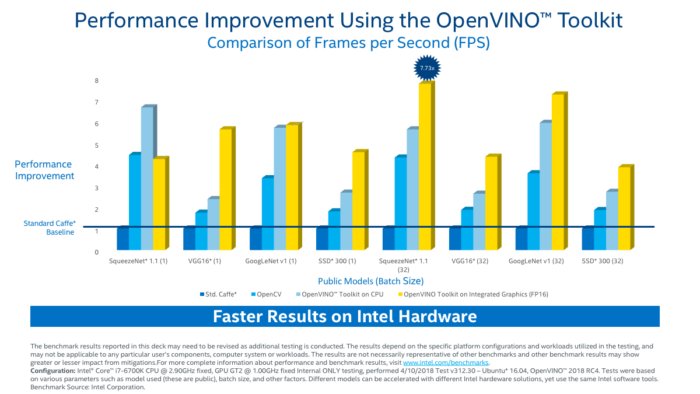
Intel recently renamed its Computer Vision SDK as the OpenVINO™ toolkit. Looking at all that’s been added, it’s not surprising Intel wanted a new name to embrace all the new functionality. Included in the toolkit are three new APIs: The Deep Learning Deployment toolkit, a common deep learning inference toolkit, and optimized functions for OpenCV and OpenVX, with support for the TensorFlow, MXNet, and Caffe frameworks.
The OpenVINO toolkit offers software developers a single toolkit for applications wanting human-like vision capabilities. It does this by supporting deep learning, computer vision, and hardware acceleration with heterogeneous support, all in a single toolkit.
Intel says the toolkit is aimed at data scientists and software developers working on computer vision, neural network inference, and deep learning deployments who want to accelerate their solutions across multiple platforms, including CPU, GPU, VPU, and FPGA. This should “help developers bring vision intelligence into their applications from edge to cloud,” according to the company.
Source: Intel Corp.
Not just for Intel
While it’s clear that Intel has included optimized support for Intel hardware top-to-bottom, support for OpenVX APIs provides a strong non-Intel connection too. The toolkit supports both OpenCV and OpenVX. Wikipedia sums up the two well as follows: “OpenVX is complementary to the open source vision library OpenCV. OpenVX in some applications offers a better optimized graph management than OpenCV.” The toolkit includes a library of functions, pre-optimized kernels, and optimized calls for OpenCV and OpenVX.
OpenVINO offers specific capabilities for CNN-based deep learning inference on the edge. It also offers a common API that supports heterogeneous execution across computer vision accelerators: CPUs, GPUs, Intel® Movidius™ Neural Compute Stick, and FPGAs.
Sorry, GPU fans, I’m more of an FPGA fan
Yes, the toolkit offers extensive support for GPUs through OpenCV and OpenVX. But I got really interested when I saw the third development guide in the list of guides: (1) Linux, (2) Windows, (3) Linux with FPGA Beta. Okay, the CPU and GPU support is “product quality” and the FPGA is only “beta,” but I still bet on FPGAs long term. I think FPGAs are going to take over the world, and I’m excited to see FPGA support here. Maybe you are too! If not, go have fun with the “product quality” CPU and GPU support. But don’t say I didn’t warn you that FPGAs will ultimately win.
Scalable Industrial Ready Kits?
There are a couple “turnkey” development systems available as vision accelerator developer kits to jump-start smart vision deployments. Intel says these kits aim to expedite the path to production and enable scalable designs. I’ve included a link to these below.
Vision systems hold incredible promise to change the world and help us solve problems. This toolkit can help – and it’s a free download to help in the development of high-performance computer vision and deep learning inference solutions.
Useful links for follow-up
